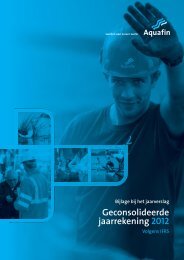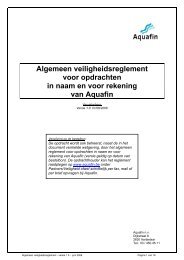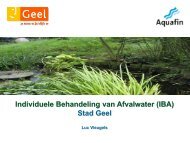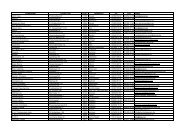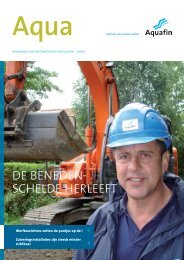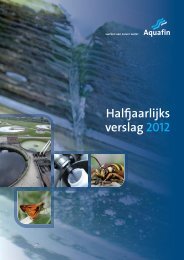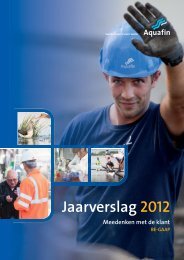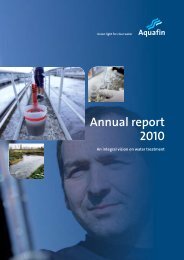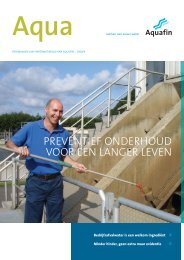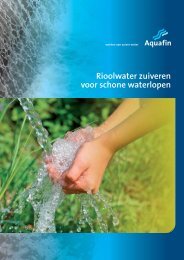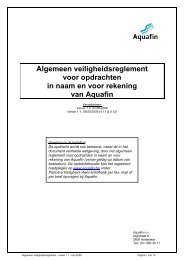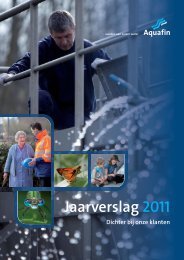Consolidated financial statement 2011 - Aquafin
Consolidated financial statement 2011 - Aquafin
Consolidated financial statement 2011 - Aquafin
You also want an ePaper? Increase the reach of your titles
YUMPU automatically turns print PDFs into web optimized ePapers that Google loves.
6<br />
<strong>Consolidated</strong> <strong>financial</strong> <strong>statement</strong> <strong>2011</strong><br />
The P-1 short-term rating remained unchanged. Even with<br />
that changed rating, <strong>Aquafin</strong> was still at the top of creditworthy<br />
companies. The company continued to enjoy the<br />
confidence of various lenders.<br />
n<br />
Active interest management<br />
Through active management of the interest risk <strong>Aquafin</strong><br />
wishes to optimize the financing costs. In May 2006, the Board<br />
of Directors approved the outlines of a dynamic management<br />
procedure for interest-rate risks. The interest policy was<br />
modified in 2008. In 2009, primarily the descriptions and<br />
definitions were modified. No changes were made to the<br />
principles themselves.<br />
Active interest management can be applied to a maximum<br />
of 35% of the underlying debt of <strong>Aquafin</strong>’s total long-term<br />
debts. Its objective is to achieve interest savings. The portfolio<br />
may be built up as follows: minimum of 65% of fixed interest<br />
rates and 35% of variable rates, 25% of which with a maximum<br />
ceiling and 10% fully variable. To cover future financing needs,<br />
the interest rate policy results in a dynamic interestmanagement<br />
programme up to 50% of the future long-term<br />
debts, with a 5-year horizon. It is important to ensure that<br />
the risks are covered and that an underlying loan matches<br />
the coverage structure.<br />
n<br />
Bookkeeping converted to the international standard<br />
As of year-end at 31 December <strong>2011</strong>, <strong>Aquafin</strong> reports<br />
according to the IFRS standards that apply. In addition to<br />
reporting in accordance with the Belgian Generally Accepted<br />
Accounting Principles (Belgian GAAP), consolidated IFRS<br />
<strong>financial</strong> <strong>statement</strong>s are also prepared. They include a balance<br />
<strong>statement</strong>, an overview of realised and unrealised results,<br />
a change overview of net equity, cash flow <strong>statement</strong> and<br />
extensive explanations, including valuation rules.<br />
EU FINE FOR BELGIUM - THE LATEST STATE<br />
OF AFFAIRS<br />
At the moment, Belgium is not compliant with the<br />
provisions of the European Urban Waste Water Directive for<br />
agglomerations of more than 10,000 people equivalents.<br />
In respect of that situation, Europe is filing an application with<br />
the European Court to have Belgium found to be in violation.<br />
With respect to Flanders, there is only one agglomeration/<br />
treatment plant – the one in Beersel – that is not completely<br />
compliant. That plant is operational, but the mandatory<br />
samples couldn’t be submitted for a full year yet.<br />
The <strong>financial</strong> results of the interest management are<br />
calculated against individual benchmarks (the result of an<br />
individual strategy in comparison with the applicable interest<br />
swap at the moment of the establishment/execution of the<br />
structure). The interest cost of the underlying loan must be<br />
taken together with the results of the structure built on top of<br />
it, in order to see <strong>Aquafin</strong>'s ultimate debt burden. The <strong>financial</strong><br />
results are offset with the drinking-water companies.<br />
New structures were established in <strong>2011</strong> for our future<br />
financing requirements. Existing strategies were also optimised.<br />
That allows <strong>Aquafin</strong> to stay within the 35% to 50% range.<br />
Half of the returns from the interest-rate management are<br />
deducted immediately from the invoice to the drinking-water<br />
companies. The other half is retained within the company as<br />
a buffer for possible optimisations. At the end of the year,<br />
the global result of all of the hedging operations combined is<br />
reviewed so that every euro placed in the buffer is deducted<br />
from the invoice to the drinking-water companies.



